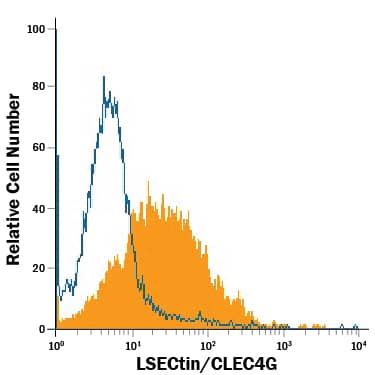Human LSECtin/CLEC4G Antibody
R&D Systems, part of Bio-Techne | Catalog # MAB2947


Key Product Details
Species Reactivity
Validated:
Cited:
Applications
Validated:
Cited:
Label
Antibody Source
Product Specifications
Immunogen
Ser54-Cys293
Accession # Q6UXB4
Specificity
Clonality
Host
Isotype
Scientific Data Images for Human LSECtin/CLEC4G Antibody
Detection of LSECtin/CLEC4G in Human Dendritic Cells by Flow Cytometry.
Human mature dendritic cells were stained with Mouse Anti-Human LSECtin/CLEC4G Monoclonal Antibody (Catalog # MAB2947, filled histogram) or isotype control antibody (MAB003, open histogram), followed by Allophycocyanin-conjugated Anti-Mouse IgG Secondary Antibody (F0101B).Detection of LSECtin/CLEC4G in hLSECtin transfected HEK293 cells vs Irrelevant transfectant by Flow Cytometry
hLSECtin transfected HEK293 cells (A) vs Irrelevant transfectant (B) were stained with Mouse Anti-Human LSECtin/CLEC4G Monoclonal Antibody (Catalog # MAB2947) and eGFP followed by Allophycocyanin-conjugated Anti-Mouse IgG Secondary Antibody (Catalog # F0101B). View our protocol for Staining Membrane-associated Proteins.Applications for Human LSECtin/CLEC4G Antibody
Flow Cytometry
Sample: Human mature dendritic cells; hLSECtin/CLEC4G transfected HEK293 cells vs irrelevant transfectant
Formulation, Preparation, and Storage
Purification
Reconstitution
Formulation
Shipping
Stability & Storage
- 12 months from date of receipt, -20 to -70 °C as supplied.
- 1 month, 2 to 8 °C under sterile conditions after reconstitution.
- 6 months, -20 to -70 °C under sterile conditions after reconstitution.
Background: LSECtin/CLEC4G
LSECtin (liver and lymph node sinusoidal endothelial cell C-type lectin), also known as C-type lectin superfamily 4, member G (CLEC4G), is a member of subgroup II of the C-type (Ca2+-dependent) lectin superfamily (1). The protein was named LSECtin because its initial expression was described to be restricted to liver and lymph node sinusoidal endothelial cells (1). Since then, however, LSECtin has also been detected in peripheral blood and thymic dendritic cells isolated ex vivo, and in monocyte-derived macrophages and dendritic cells at the RNA and protein level (2). Human LSECtin is an approximately 40 kDa, single-pass, type II transmembrane glycoprotein that is 293 amino acids (aa) in length. It contains a short N-terminal cytoplasmic tail (aa 1‑31) and a 21 aa transmembrane region. Its extracellular region consists of two N-linked glycosylation sites (aa 73 and 159), a coil‑coil neck domain (aa 96‑136), a C‑type lectin-like domain (CTLD) of the type found in human DC‑SIGN and DC‑SIGN receptor (aa 165‑289), and a C-terminal Ca2+-dependent carbohydrate‑recognition domain (C-type CRD) (1). Human LSECtin shares 64% aa sequence identity with mouse LSECtin. LSECtin binds to mannose, GlcNAc, and fucose in a Ca2+-dependent manner (1‑3). In addition, LSECtin has the ability to bind to surface glycoproteins of enveloped viruses (3, 4). In particular, interaction of LSECtin with the surface glycoproteins of severe acute respiratory syndrome (SARS) coronavirus and Ebola virus has been described, and LSECtin‑mediated infection of cells by Ebola virus has been demonstrated (3, 4).
References
- Liu, W. et al. (2004) J. Biol. Chem. 279:18748.
- Dominguez-Soto, A. et al. (2007) Blood 109:5337.
- Powlesland, A. et al. (2008) J. Biol. Chem. 283:593.
- Gramberg, T. et al. (2005) Virology 340:224.
Long Name
Alternate Names
Gene Symbol
UniProt
Additional LSECtin/CLEC4G Products
Product Documents for Human LSECtin/CLEC4G Antibody
Product Specific Notices for Human LSECtin/CLEC4G Antibody
For research use only
